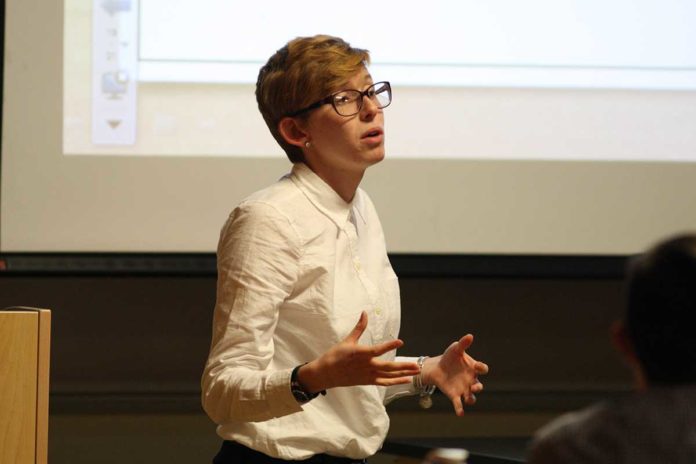Speakers from SRU’s Project to End Human Trafficking presented the “I Don’t Love Human Trafficking” event, which was cosponsored by the University’s Department of Gender Studies on Feb. 2 in the Vincent Science Center.
With Valentine’s Day less than two weeks away, the presenters recognized that many students on campus would be purchasing gifts for loved ones in the form of chocolate, flowers, and jewelry. Junior psychology major and vice president of the Project to End Human Trafficking, Erin O’Connor explained the reason behind the event.
“We wanted to be able to educate people on how these purchases are related to modern day slavery, and also how they can make more ethical (purchasing) choices,” O’Connor said.
Four students from the Project each described one aspect of human trafficking and what actions could be taken to prevent inadvertently supporting the illegal industries. Project recorder and creative writing and gender studies major, Sara Naughton spoke about the jewelry industry. Project treasurer and social work and gender studies major, Jessica Tager described the flower industry. President of the Project and a sophomore social work and psychology major, Megan Riley spoke about the chocolate industry. O’Connor provided various statistics and information on sex trafficking.
O’Connor started the event by describing the two major forms of human trafficking: labor trafficking and labor exploitation. She noted that the major difference between the two atrocities are that human trafficking involves the use of force, fraud, or coercion against workers, while labor exploitation focuses on the unfair treatment of workers in the form of insufficient wages or dangerous working conditions. She stressed the fact that human trafficking and labor exploitation are not far-flung phenomena that only occur in the farthest corners of the world, but rather issues that together create a $150 billion global industry and force 20 to 30 million people into slavery in every area of the world.
Naughton described how the jewelry industry contributes to slaves laboring in terrible working conditions. She explained that 15 to 22 percent of Peru’s exported gold is mined through the use of either captive workers who are unable to work off a debt or children who work in mines for less than $2 a day. She continued by informing the audience that 75 percent of all rough diamonds are mined through less than ideal circumstances in Africa, but that programs such as the Diamond Development Initiative work to transform traditional diamond mining into a safe fair-trade and sustainable industry.
Tager followed with a description of the floral industry. She reported that 80 percent of the flowers originating in Ecuador are harvested through child laborers, who often work over 70 hours per week while being exposed to harmful levels of pesticides and tropical diseases. Tiger said Colombia has made some progress by eliminating the use of child labor within the past 10 years; however women who become pregnant while employed are often fired on the spot if their pregnancy is discovered by their employer. Tager also encouraged the audience to purchase artificial flowers made from sustainable or recycled materials through companies such as Ecoflower, which combines eco-friendly practices with the floral industry.
Riley said major chocolate companies such as Hershey, Mars and Nestle all source a large percentage of their cacao through slave labor companies on the Ivory Coast. While Mars, Hershey and Ferrero have claimed to be taking measures to be slave-free by 2020, there is a lack of recent data to suggest that the companies are making adequate progress towards this goal, Riley said. She urged students to purchase chocolate through companies that have gone through extensive third-party certification processes to ensure that goods are being ethically sourced.
O’Connor was the last speaker and she spoke of the enormity of the global sex trafficking industry.
“It’s something that has to concern us, because it’s not just happening ‘over there,’ far away from us,” O’Connor said.
O’Connor said that 98 percent of all sex trafficking victims are female, and that girls under the age of 18 are especially prone to abduction and trafficking because of society’s obsession with youthful looks.
The event concluded with an interactive map activity where the audience discovered that an average of 49 slaves work to support the lifestyle of a typical Slippery Rock University student.
“We have the opportunity to make a large impact,” Riley said. “We do have power through minding what we say and who we support.”
A call to action was given where audience members could choose to write postcards and letters to both companies who utilize slave labor and those who have chosen to move away from the practice.








Do you have a source stating that 80 percent of the flower harvesters in Ecuador are children? Thank you.
Do you have a source stating that 80 percent of the flower harvesters in Ecuador are children? Thank you